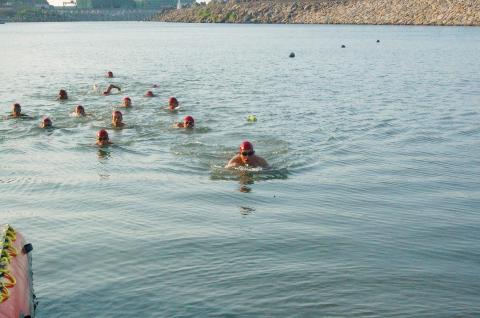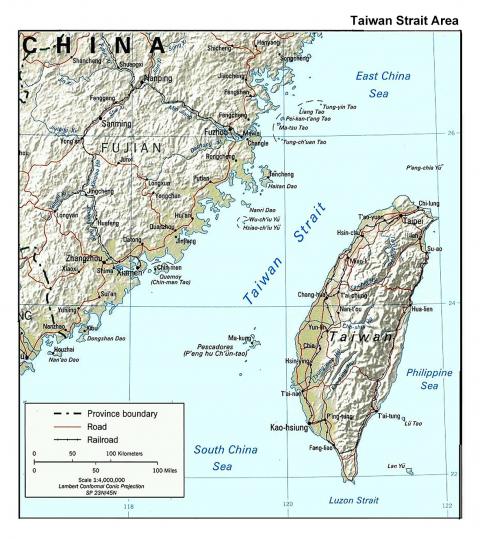Aug. 19 to Aug. 25
After swimming for 8.5 hours and subsisting on just bread and ginger soup, an exhausted Wang Han (王瀚) reached the shores of Morocco.
The former actor’s feat made the headlines on Aug. 24, 1986, with the United Daily News (聯合報) calling it a “risky journey across the demonic strait.”

Photo: CNA
Some praised him as the “first Chinese person to swim across the Strait of Gibraltar,” while others noted that he was the “first in the East.” This was a time when everyone in Taiwan was still taught to identify as Chinese, and Wang claimed that he did it for the “spirit of the Chinese people.”
Wang would end up traversing, whether alone or in a relay team, 11 more major world straits over the following 12 years. However, there was one challenge left, one that was closest to home: The Taiwan Strait, which was off-limits for political reasons.
ACROSS THE DEMON STRAIT

Photo: Yang Pei-hua, Taipei TImes
While most reports note the Strait of Gibraltar exploit as the beginning of Wang’s legendary run, he made his maiden long-distance voyage here in Taiwan in late 1985. A January 1986 report in Television Weekly (電視週刊) details his swim from Pingtung’s Donggang Township (東港) to Siaoliouciou island (小琉球).
This attempt was sponsored by the actor’s guild Wang belonged to, and was meant to “demonstrate the resilient and adventurous spirit of the Chinese people and to boost the image of entertainers and performers.”
Wang was never formally trained as a swimmer. Born in 1954 in rural Hsinchu, he honed his aquatic skills in the Toucian River (頭前溪) before he became acquainted with the ocean during college. At the age of 31, he walked away from acting and modeling to focus on swimming.

Photo courtesy of Wikimedia Commons
After making it to Siaoliouciou in just over six hours, Wang told the press that he would tackle the English Channel next. It isn’t clear why he ended up crossing the Strait of Gibraltar first, but there he was on the shores of Tarifa, Spain on Aug. 22, 1986. He warmed up for about an hour, and plunged in.
Despite his leg cramping up just an hour into the ordeal and strong currents pushing against him, Wang made it. The water was quite cold; fortunately the supply boat was stocked with ginger tea that kept him warm. He collapsed on the beach for a moment before pushing himself up to greet the crowd running toward him.
During the ensuing celebration, the Spanish host noted that only three people had completed the feat in modern history before Wang: two Europeans and a South Asian, making him the first East Asian to make the list.
“What’s inspiring is that Wang is not a professionally-trained swimmer,” the Minsheng Daily (民生報) reported. “Experts have criticized his form as less than ideal, and there are many people who have better stamina and skills,” it stated before praising his determination and perseverance that “embodied the spirit of the Chinese race.”
ULTIMATE GOAL
Huang swam the English Channel next in 1988, followed by the Bosphorus in 1989 and a channel around Maui, Hawaii in 1990, consistently completing one challenge per year until 1998. Three of these were solo trips while nine were done with a relay team. News footage of his team crossing the US-Canadian Strait of Juan de Fuca in 1993 and Australia’s Cleveland Bay in 1996 can be found on YouTube. Due to the prevalence of sharks in the Australian waters, the team had to swim in shark-proof cages, a first for Wang.
Wang told the press after crossing the Tsugaru Strait in 1994 that it was his eighth conquest and that he had four more to go, the final one being the Taiwan Strait. However, his 12th journey was across the Strait of Sicily in 1998; he presumably could not cross the Taiwan Strait due to tense relations between Taiwan and China, especially with the Third Taiwan Strait Crisis breaking out just two years before.
It wasn’t until 2007 that Wang announced plans to realize his dream, recruiting 24 young athletes who would each swim one hour at a time. He lamented that during all this time, the closest strait to home was also the farthest, and it wouldn’t have been possible without connections through famed Olympian sprinter Chi Cheng (紀政).
“I’m accustomed to spending my days in the ocean,” he told TVBS. “Although I haven’t challenged any strait in the past 10 years, I have been preparing this whole time to cross the Taiwan Strait.”
But the currents were unforgiving, and the team had advanced just 23km in 24 hours, while getting swept back 2km in the last hour. Coupled with the supply boat running low on fuel, the swimmers aborted the mission.
Vowing to give it another shot, Wang started recruiting people again in January 2008, but curiously there are no news items about the results — indicating that he either never made the trip or failed again.
Taiwan in Time, a column about Taiwan’s history that is published every Sunday, spotlights important or interesting events around the nation that have anniversaries this week.

April 14 to April 20 In March 1947, Sising Katadrepan urged the government to drop the “high mountain people” (高山族) designation for Indigenous Taiwanese and refer to them as “Taiwan people” (台灣族). He considered the term derogatory, arguing that it made them sound like animals. The Taiwan Provincial Government agreed to stop using the term, stating that Indigenous Taiwanese suffered all sorts of discrimination and oppression under the Japanese and were forced to live in the mountains as outsiders to society. Now, under the new regime, they would be seen as equals, thus they should be henceforth

Last week, the the National Immigration Agency (NIA) told the legislature that more than 10,000 naturalized Taiwanese citizens from the People’s Republic of China (PRC) risked having their citizenship revoked if they failed to provide proof that they had renounced their Chinese household registration within the next three months. Renunciation is required under the Act Governing Relations Between the People of the Taiwan Area and the Mainland Area (臺灣地區與大陸地區人民關係條例), as amended in 2004, though it was only a legal requirement after 2000. Prior to that, it had been only an administrative requirement since the Nationality Act (國籍法) was established in

With over 80 works on display, this is Louise Bourgeois’ first solo show in Taiwan. Visitors are invited to traverse her world of love and hate, vengeance and acceptance, trauma and reconciliation. Dominating the entrance, the nine-foot-tall Crouching Spider (2003) greets visitors. The creature looms behind the glass facade, symbolic protector and gatekeeper to the intimate journey ahead. Bourgeois, best known for her giant spider sculptures, is one of the most influential artist of the twentieth century. Blending vulnerability and defiance through themes of sexuality, trauma and identity, her work reshaped the landscape of contemporary art with fearless honesty. “People are influenced by

Three big changes have transformed the landscape of Taiwan’s local patronage factions: Increasing Democratic Progressive Party (DPP) involvement, rising new factions and the Chinese Nationalist Party’s (KMT) significantly weakened control. GREEN FACTIONS It is said that “south of the Zhuoshui River (濁水溪), there is no blue-green divide,” meaning that from Yunlin County south there is no difference between KMT and DPP politicians. This is not always true, but there is more than a grain of truth to it. Traditionally, DPP factions are viewed as national entities, with their primary function to secure plum positions in the party and government. This is not unusual